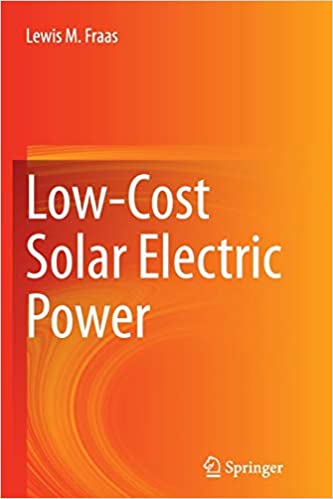
This book describes recent breakthroughs that promise major cost reductions in solar energy production in a clear and highly accessible manner. The author addresses the three key areas that have commonly resulted in criticism of solar energy in the past: cost, availability, and variability. Coverage includes cutting-edge information on recently developed 40¿ efficient solar cells, which can produce double the power of currently available commercial cells. The discussion also highlights the potentially transformative emergence of opportunities for integration of solar energy storage and natural gas combined heat and power systems. Solar energy production in the evening hours is also given fresh consideration via the convergence of low cost access to space and the growing number of large terrestrial solar electric power fields around the world.
Dr. Fraas has been active in the development of Solar Cells and Solar Electric Power Systems for space and terrestrial applications since 1975. His research team at Boeing demonstrated the first GaAs/GaSb tandem concentrator solar cell in 1989 with a world record energy conversion efficiency of 35¿, garnering awards from Boeing and NASA. He has over 30 years of experience at Hughes Research Labs, Chevron Research Co, and the Boeing High Technology Center working with advanced semiconductor devices. In a pioneering paper, he proposed the InGaP/GaInAs/Ge triple junction solar cell predicting a cell terrestrial conversion efficiency of 40¿ at 300 suns concentration. Having become today’s predominant cell for space satellites, that cell is now entering high volume production for terrestrial Concentrated Photovoltaic (CPV) systems. Since joining JX Crystals, Dr. Fraas has pioneered the development of various thermophotovoltaic (TPV) systems based on the new GaSb infrared sensitive PV cell. Dr. Fraas holds degrees from Caltech (B.Sc. Physics), Harvard (M. A. Applied Physics), and USC (Ph.D. EE).
Dit boek beschrijft op een heldere en zeer toegankelijke manier recente doorbraken die grote kostenreducties in de productie van zonne-energie beloven. De auteur gaat in op de drie kernpunten die in het verleden vaak tot kritiek op zonne-energie hebben geleid: kosten, beschikbaarheid en variabiliteit. Er wordt ook aandacht besteed aan recent ontwikkelde zonnecellen met een rendement van 40 %, die tweemaal zoveel vermogen kunnen produceren als de momenteel beschikbare commerciële cellen. De discussie belicht ook de potentieel transformatieve opkomst van mogelijkheden voor de integratie van zonne-energie opslag en aardgas warmtekrachtkoppeling systemen. De productie van zonne-energie in de avonduren krijgt ook nieuwe aandacht via de convergentie van goedkope toegang tot de ruimte en het groeiende aantal grote terrestrische zonne-elektriciteitsvelden in de wereld.
Dr. Fraas is sinds 1975 actief in de ontwikkeling van zonnecellen en zonne-energiesystemen voor ruimte- en terrestrische toepassingen. Zijn onderzoeksteam bij Boeing demonstreerde de eerste GaAs/GaSb tandem concentrator zonnecel in 1989 met een wereldrecord energie-omzettingsefficiëntie van 35¿, waarmee hij prijzen van Boeing en NASA in de wacht sleepte. Hij heeft meer dan 30 jaar ervaring bij Hughes Research Labs, Chevron Research Co, en het Boeing High Technology Center met het werken met geavanceerde halfgeleiderelementen. In een baanbrekend document stelde hij de InGaP/GaInAs/Ge drievoudige junctie zonnecel voor die een cel terrestrische omzettingsefficiëntie voorspelde van 40¿ bij 300 zonconcentratie. Deze cel is de belangrijkste cel voor ruimtesatellieten geworden en wordt nu in grote hoeveelheden geproduceerd voor terrestrische systemen voor geconcentreerde fotovoltaïsche energie (CPV). Sinds zijn indiensttreding bij JX Crystals heeft Dr. Fraas pionierswerk verricht bij de ontwikkeling van diverse thermofotovoltaïsche (TPV) systemen op basis van de nieuwe GaSb infraroodgevoelige PV-cel. Dr. Fraas is afgestudeerd aan Caltech (B.Sc. natuurkunde), Harvard (M.A. toegepaste natuurkunde), en USC (Ph.D. EE).
Geef een reactie
Je moet ingelogd zijn op om een reactie te plaatsen.